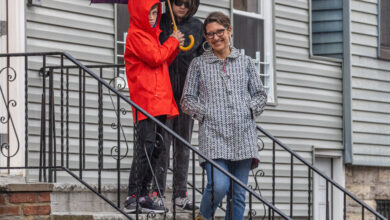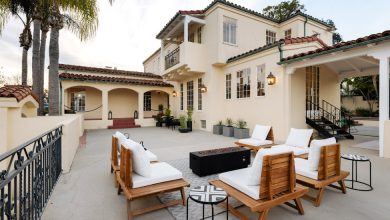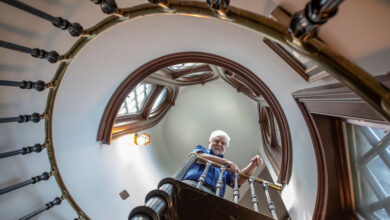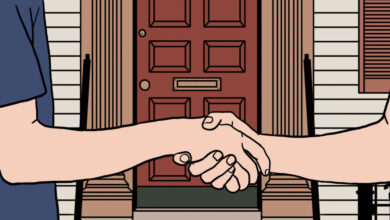A Florentine Villa Whose Story Is One of Family
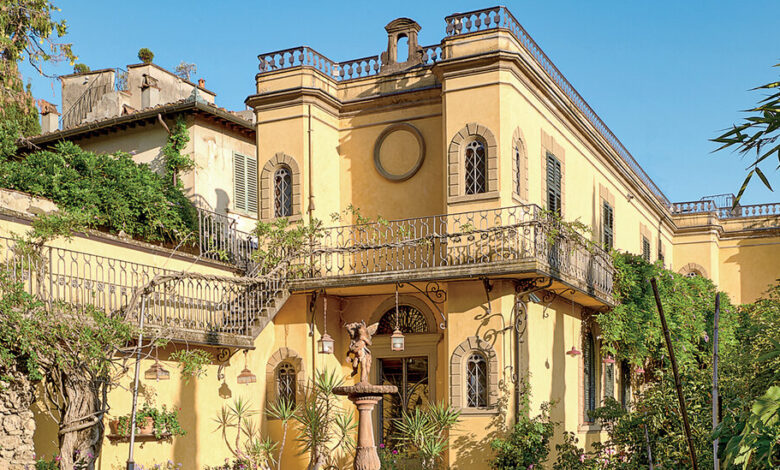
IN 1974, LORETTA CAPONI found a house in the leafy San Niccolò neighborhood of Florence, Italy. She and her husband, the painter Dino Caponi, had spent 20 years living near the city center, but Loretta, the owner of a namesake local fine-linen-and-embroidery business, loved roses, and this house — nestled in the lush hillside south of the Arno River — had a garden.
The 15th-century villa, named Bellavista for its expansive views of the city, has had a complicated history. It was built by a member of the noble Miniati family, presumed benefactors of a nearby chapel; it was eventually sold back to its original family in 1506. A few centuries later, in the mid-1800s, the Swiss-Italian painter Antonio Ciseri bought the property along with its adjacent green hillside. The story goes that one of Ciseri’s daughters became secretly engaged to the son of Giuseppe Poggi, the master planner tasked in 1865 with the urban renovation of Florence, then the country’s newly minted capital. He installed wide boulevards along the city’s perimeter, inspired by those in Paris, but the Bellavista property lay in his path. So Poggi later convinced his future daughter-in-law’s father to sell a slice of his land to the city, allowing him to create a crucial ring road that is now visible from the house’s living room. (The Caponis also suspect that at some point in the mid-1800s part of the house operated as a Catholic church because of a bell niche built into the house’s facade, as well as a living-room layout that resembles a nave.)
A hundred years later, after World War II, Bellavista was bought by an American industrialist, who subsequently sold it to Italian entrepreneurs who carved it into more than a dozen small apartments. When the Caponis bought the property decades later, they immediately set about returning it to a family home, scraping back layers of paint to reveal 19th-century frescoes and eliminating several kitchens and bedrooms — though as Lucia Caponi, Loretta’s daughter, now in her 70s and the heir to her mother’s business, says with a laugh, “We still have eight bathrooms.”
By the time they purchased the house, Loretta Caponi was becoming a renowned purveyor of fine hand-embroidered nightgowns and linens, beloved by generations of aristocratic European and Middle Eastern families. (The company keeps decades of files of bespoke crests and other made-to-order embroideries.) Since 2015, Lucia’s son Guido Conti Caponi has served as chief operating officer.
As the company became a multigenerational Caponi affair, so, too, did Bellavista. Lucia married her high-school sweetheart, Renato Conti, in the garden; guests congregated around a small pond under a pair of twined wisteria vines. They feasted on long tables laid with Loretta’s linens, stitched with images of wheat and red roses, inspired by those in the garden. After the wedding, the couple moved into the house with her parents and have lived there ever since. Lucia and Renato’s sons, Duccio and Guido, now 37 and 32, were raised at Bellavista and, though the house was informally split into connected apartments — one for Loretta and Dino and the other for Lucia, Renato and their sons — the entire family gathered nightly in the central communal kitchen for meals.
As is fitting for a house inhabited by one clan for 45 years, the design of each room evolved gradually, the result of an ongoing, unplanned collaboration. “My family is full of collectors,” says Guido. “We go crazy for it. But it’s nice because every piece has a history.” For years, whenever anyone traveled, they brought something back to the villa. Part of a set of 19th-century floral Richard Ginori china that was made for a wedding hangs on one dining-room wall; Loretta and Lucia found some of it in an antiques shop in Florence, and more pieces from the same set in flea markets in Paris and London. On another wall hangs a 19th-century painted tapestry depicting bathing nudes that Lucia and Renato purchased at a market near Avignon, France, in the ’80s. There are fruit-adorned Art Deco plates, found nearby in Tuscany, above the stovetop in the kitchen; giant wood bookcases from the National Central Library of Florence lining the walls of the sunken living room; and a series of four early 20th-century plaster busts, purchased by Lucia and sourced from an Italian sports club, arranged atop a cabinet in Renato’s office. The Caponis amassed so many pieces that in 1989, Renato and Lucia opened their own antiques shop, Casa Wolf Galleria, in the Borgo San Frediano neighborhood. Now Duccio, an interior architect, runs the store, as well as a workshop for new pieces. (He also oversaw the redesign of Loretta Caponi’s Florence store in 2018.)
Still, there’s plenty left at Bellavista, where seemingly every available surface in the house is stacked with groups of small objects found by different family members. There are clay and glass ducks (collected by Loretta), hounds (Renato) and angels (Renato and Lucia). Guido remembers his grandmother always saying, “This is the way you remember your trip. Of course, you have pictures, and pictures in your mind, but when you buy things that have a memory inside, your house is made of pieces that speak.”
LORETTA CAPONI WAS born in 1924 in Fiesole, just outside of Florence; she was sewing and embroidering dresses and nightgowns from a young age. After World War II, she befriended a woman who regularly traveled to Paris and who began selling Loretta’s bras and nightgowns to wealthy friends there. The money Loretta earned from the arrangement was enough to buy her first home.
Around the same time, Loretta began collecting antique embroideries. Today, the archive has over 30,000 pieces, with garments once owned by Queen Victoria, a dress that belonged to Empress Elisabeth of Austria and monogrammed fabrics from Victor Emmanuel I. Many of the pieces Loretta collected informed her designs — a nightdress once owned by Napoleon’s sister Pauline Bonaparte, for example, inspired one of her most popular nightie styles, the Paolina. By 1967, she was able to open a tiny shop on Borgo Ognissanti in central Florence, in whose front window she displayed her first design — a smocked nightgown in colorful printed cotton, rather than nylon, which had been in vogue. Over the years, Loretta produced more than 20,000 designs. When she died of cancer in 2015 at age 91, “her last words were about nightgowns,” Guido recalls.
These days, all of the company’s bespoke production is still done in-house. The embroideries are made entirely by hand, involving a process called spolvero, in which minuscule holes are made over the lines of a drawing, then dusted over with a blue-solution-soaked sponge. “Our aim is to keep tradition as it has always been, but at the same time, to innovate a new way of doing business,” Guido says.
That sense of tradition also extends to their home. When the novel coronavirus struck, they were required to close down the atelier and temporarily shutter the company’s two stores in Florence and Forte dei Marmi, which have since reopened. Lucia and Guido now sit once again at neighboring desks in the atelier, but continue to bring their work to Bellavista, where Guido also lives. “Home is my refuge,” Lucia says. On Sundays, she cooks, reads and tends the garden. The bed she and Renato share, which is framed by an ornate plaster headboard they believe was part of the altarpiece from when the house was most likely a church, is now dressed with Loretta Caponi linens stitched with dripping purple wisteria, just like the pair of vines they were married beneath in the garden outside their window.
“This house is alive,” Lucia says. “It’s not a perfect house, and sometimes it’s not perfectly maintained. But it’s a true house. Questa è una vera casa.”
Source link



